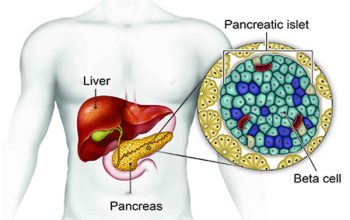Diabetes is a lifestyle disease that is not uncommon to anyone in this age and era. Every other person we come across today either have diabetes or live with a loved one who has fallen prey to the disease. Uncontrolled and untreated diabetes can lead to various other health complications, affecting multiple organs within the human body with even fatal results. In this article, we will cover diabetes in detail as well as the restrictions on the sugar intake of a diabetic patient.

What Is Diabetes?
Diabetes can be described as a chronic disease that occurs when blood sugar levels are high. In a healthy person, the hormone insulin produced by the pancreas assists to break down the glucose from food to produce energy. However, this does not happen in the case of a diabetic as the insulin produced by the pancreas is either insufficient or the produced insulin is not utilized properly by the body. As a result of this, glucose gets accumulated in the blood not reaching the cells on time leading to various health issues over time. The intensity of diabetes may vary from person-to-person where doctors may diagnose some people as having borderline diabetes whereas yet others as having a serious case who are at risk for further health complications as a result. Diabetes can be classified as type 1 and type 2 diabetes wherein the former produces less insulin that needs to be administered through medications whereas in the latter insulin produced by the pancreas is not used by the body effectively. Type 2 diabetes is what is more commonly seen in people. Another form of diabetes is gestational diabetes which is caused during pregnancy in some women.
Symptoms & Diagnosis
Some common symptoms of diabetes are as follows:
- increased sense of hunger
- feeling tired easily
- feeling thirsty more frequently
- urge to pee more than usual
- skin tends to feel dry and itchy
- mouth feels parched
- vision tends to get blurry
- erectile dysfunction in some males
For type 1 diabetes additionally, people often experience unexplained weight loss despite following the same diet pattern. In some cases, it leads to nausea and vomiting. For those having type 2 diabetes, yeast infections around skin folds are a common symptom as well as delay in healing of wounds; along with numbness in legs and feet.
Who Is More Prone to get Diabetes
In the case of type 1 diabetes the following people are more prone to the illness:
- Those with diseases of the pancreas, since insulin production gets adversely affected.
- People who have a family history of diabetes tend to get type 1 diabetes at an early stage in life.
- Certain infections can adversely affect pancreatic health, which in turn can cause diabetes.
In the case of type 2 diabetes, the following people have higher chances of getting diabetic:
- An inactive lifestyle excluding exercises and unhealthy eating where people tend to gain weight rapidly and become obese. Such people have a higher risk of getting type 2 diabetes.
- The glucose tolerance of some people is impaired which can cause type 2 diabetes.
- Gestational diabetes can give rise to type 2 diabetes in some ladies.
- Genetics sometimes plays a role in someone getting type 2 diabetes.
- Women who have PCOS stand a greater risk of getting type 2 diabetes.
If a person experiences one or more of the above symptoms then it is best to consult a doctor who will be able to diagnose the type of diabetes that the person is suffering from. The doctor will opt for one of the 2 tests which is either a fasting blood sugar test where the doctor tests the person after at least 8 hours of fasting or go for glycated hemoglobin tests which does not require any fasting. The normal blood sugar level for a healthy person is less than 140 mg/dL.
How Much Sugar Can A Diabetic Person Consume
Ask a diabetic person how often he consumes sugary food items and one would often encounter them either lying or trying to hide facts. Either way, those who have diabetes have no way out than to control their sugar intake if they cannot stop it altogether. One may think that direct consumption of sugary products alone poses increased health risks to those having diabetes not realizing that sugar in many other forms is also best avoided. These include maple syrup, honey, rice syrup, corn syrup high in fructose, molasses and others. Whether it is refined sugar or sugar in its purest form, the body of a diabetic person reacts to the sugar intake in the same manner in both cases. Therefore, it is very important to identify what other food products contain sugar in various hidden forms and consume the food either in reduced quantities or altogether avoid it if possible.
People mistakenly associate sugar with jams, chocolates, cookies, fruit juices, aerated drinks and others alone not realizing that their favorite protein bars, granola bars, flavored yogurt, peanut butter, vanilla almond milk and the likes which they consume as healthier versions of food also contain sugar. The blood sugar level is affected by both starches as well as sugar intake. Therefore, someone with diabetes needs to be mindful of the amount of sugar that goes into their body. One of the best choices in this regard would be to go for foods that are lower on the glycemic index (GI) which measures the effect that different kinds of food items have on the blood sugar levels. So, it is advised to consume fresh vegetables, low-fat milk, legumes, whole grains, etc to suffice the carb requirement of the body including limited consumption of fresh fruits. Fibrous food is also excellent for diabetics. The healthy recommendation on sugar intake for the average male is 36gms which is equivalent to 9 teaspoons and for females, it is 25 gms which is about 6 teaspoons, per day, as recommended by doctors. In terms of calories, the allowed amount is 150 for males and 100 for females from sugar. So, no doubt that a diabetic is allowed either nil or a much lesser amount of sugar intake. It is best to sit with your doctor and decide how much sugar can go inside your body. Other factors that need to be looked into are as follows:
- Consume smaller portions of meals, increasing the frequency of the same for up to 5 meals a day.
- Opt for food rich in fiber to supply the body with adequate energy subsequently controlling blood sugar level.
- Choose carbs that are low on the glycemic index.
- Know that lean protein and lean fats are friends of a diabetic.
- Avoid starchy vegetables.
- Avoid junk food and sugary snacks.
- Go for fresh fruits avoiding fruit juices.
- Know that processed foods do more harm than good so avoid it altogether.
- Limit per day sodium consumption.
Conclusion
Being mindful of the food that goes inside our body goes a long way in sustaining a person’s health throughout their life. Especially for people with health conditions like diabetes, extra caution needs to be practiced to avoid related complications later on. Healthy food intake with less sugar, coupled with regular exercise is the best form of self-care that a diabetic person can gift themselves and this is also what shapes their health and happiness in the long run.


